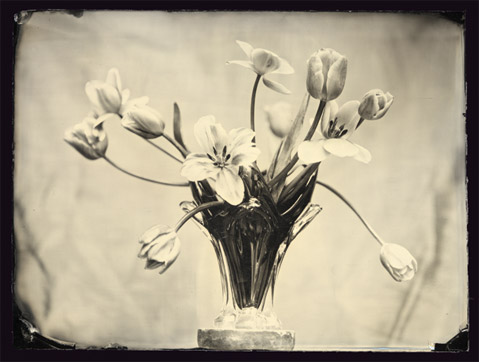Vintage Camera, Fresh Images
Luther Gerlach at Telios Design House

VINTAGE CAMERA, MODERN EYE: In the era of pocket-sized point-and-shoots and Hipstamatic iPhone apps, it seems everyone’s a photographer. But Luther Gerlach does things a little differently. “I’m a very non-computer person,” he explained last week as he popped a DVD into the disk drive of a laptop at Telios Design House (131 E. Anapamu St.) and waited in vain for it to launch.
Gerlach is the son of a social and cultural anthropologist who learned the art of documentary photography and film from his father. Since childhood he has been fascinated with early photography—daguerreotypes, tintypes, ambrotypes, calotypes—the kinds of prints made in the early years of photography: approximately 1850-1900. As his fascination with these early forms has grown, Gerlach has moved from a career in more traditional photographic forms to a professional life devoted to teaching and practicing historic photographic processes. Today, his darkroom is a GMC moving truck filled with many of the chemicals and compounds Louis Daguerre himself would have used: silver nitrate, collodion, cyanide, volcanic ash, and 190-proof alcohol. Having toyed with antique cameras for years, he’s even begun building his own.
Standing in the window of Telios Design House, just across from the Sunken Gardens, is a specimen of a camera. At 85 pounds, not counting the lens or the filmholder, it’s about as far from a modern digital camera as it gets. This is Gerlach’s 22”x30” format wet-plate camera, the largest of its kind in the world. “Wet plate” refers to the fact that the image as it develops inside the camera is literally dripping wet with chemicals.
Nearby hangs a series of ambrotypes made with the wet-plate camera. The sheets of glass on which these images appear vary from cobalt blue to black to clear to ruby red. In one, a woman naked from the waist up lies at the base of a tree, its branches rising around her like bony fingers. It’s a scene inspired by the ballet Giselle, and Gerlach brings a Victorian sensibility to his rendering of the dancer’s pale body against the dark tangle of undergrowth.
On the facing wall hangs a series of tintypes—images printed on metal—again featuring the naked female body in nature. This time, the model sits in various poses in the roots of a giant sycamore, sometimes gazing into space, sometimes staring directly at the lens. Not all Gerlach’s subjects are nudes; there are some haunting landscapes of the Louisiana bayou with oaks draped in Spanish moss, and a number of still-life shots in which tulips and orchids in glass vases appear at once luminous and otherworldly. There’s a scene from the Ventura County Fair in which a skeleton head leers above a cotton-candy stall, and a series of soft-porn images—a reminder of one of early photography’s primary subjects. Yet Gerlach’s characters all have something of the modern world about them. Despite the archaic process behind them, these are not attempts to reproduce historically accurate images. Instead, Gerlach reawakens in the viewer the shock of seeing a subject’s likeness captured in light: that sensual, voyeuristic, alchemical sorcery that’s all but forgotten in the digital age.
DON’T MISS THIS: A few for the calendar: America Martin’s work is up at the Elizabeth Gordon Gallery (15 W. Gutierrez St.) through March 12. The Colombian-American artist is a favorite with celebrity collectors, and her bold, cubist style has strong echoes of Picasso and Matisse.
Over at the Santa Barbara Museum of Art (1130 State St.) there’s an exhibition of more than 60 Japanese woodblock prints by Tsukioka Kōgyo featuring scenes from Noh dramas. Katherine Saltzman-Li, UCSB professor of Japanese literature and theater, will give a related lecture on Sunday, February 20, at 2:30 p.m. in the museum’s Mary Craig Auditorium. The exhibit runs through May 15.
And now through February 26, Jane Deering Gallery (25 E. De la Guerra St.) hosts the group show Multiples, a collection of contemporary work by U.K. and U.S. artists, including Joan Tanner and Wayne McCall.



